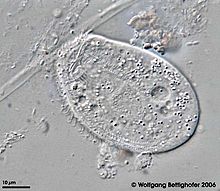
Chilodonella uncinata

Chilodonella uncinata is a single-celled organism of the ciliate class of alveoles. As a ciliate, C. uncinata has cilia covering its body and a dual nuclear structure, the micronucleus and macronucleus. Unlike some other ciliates, C. uncinata contains millions of minichromosomes (somatic chromosomes) in its macronucleus while its micronucleus is estimated to contain 3 chromosomes. Childonella uncinata is the causative agent of Chilodonelloza, a disease that affects the gills and skin of fresh water fish, and may act as a faculitative parasite of mosquito larva. Chilodonella uncinata has a cosmopolitan distribution. It is suspected to act as a facultative endoparasite of the larvae of the Culex, Aedes, and Anopheles mosquito larva. It lives in fresh water ponds, lakes, creeks, and bayous where it feeds on bacteria and other microbes. Microscopic examination of cytological samples showed that mosquito larva containing subcutaneous encysted C. uncinata had a 25-100% mortality in the mosquito larva, but no viability examinations were conducted. Chilodonella uncinata has a broad thigmotatic zone that is two-thirds the length of the body width and has a pronounced anterior beak that is directed to the left. It can be maintained under laboratory conditions in a cereal wheat grass media inoculated with Klebsiella sp. Optimal growth occurs between 25 and 30 °C. C. uncinata is capable of sporulation and can resist environments with limited resources for a period of time. All ciliates have two nuclei, but they differ in their structure of the somatic nucleus. All ciliates except Karyorelictea have a dividing macronucleus. C. uncinata also has a dividing macronucleus, but it modifies its macronuclear genome from the maternal micronuclear genome by producing macronuclear chromosomes that contain one or two open reading frame (ORFs). The average size of these macronuclear chromosomes is 4 kbit/s. The macronuclear chromosomes are also amplified to produce a high variable copy number between the chromosomes. For example, chromosome A may have 500 copies while chromosome B only has 5 copies in the macronucleus. This leaves the macronuclear genome with millions of individual chromosomes, all containing telomere ends, only one ORF, and little area for transcription factor binding for initiation of transcription. Internally eliminated sequences (IES) are noncoding regions of the germ-line genome found in Ciliates. They are defined as sections of DNA removed from the diploid micronuclear genome during which a copy of the micronuclear genome is converted to the macronuclear genome even though errors occur in which an IES sequence may not be deleted. There is little conservation of motifs between Ciliate species; however, C. uncinata, like other ciliate species, show a conserved IES sequence motif within a species. It is unknown if IES sequences have a function in the genome, but in the ciliate Paramecium, an IES sequence is used to determine the mating type of an individual. When a specific IES sequence is not deleted from the developing somatic nucleus, then it is type O mating type. However, if that IES is deleted from the developing macronucleus, it is type E mating type. Paramecium can only mate with individual of opposite mating type. Unlike Tetrahymena or Paramecium, it has been observed that C. uncinata has a larger number of IES sequences within a single protein-coding gene than in other ciliates . Also there exists populations of C. uncinata that contain an IES sequence that other populations do not carry. Chilodonella uncinata has sexual conjugation for recombination, and replication of the cell occurs by asexual division
